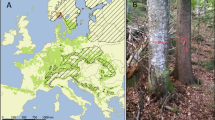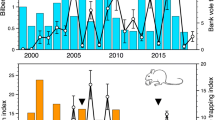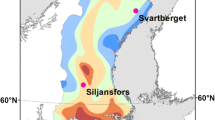Abstract
Correlations between mast fruiting of bilberry Vaccinium myrtillus and peak levels of Clethrionomys-voles have been reported from both Norway and Finland, but there has been a discussion whether this is a bottom-up or a top-down relationship. In a multiple regression model, 65% of the variation in a bilberry production index calculated from game reports from southern Norway 1932–1977 could be explained by the berry index of the two preceding years and climate factors acting during key stages of the flowering cycle. High vole populations in previous years did not contribute to explain the fluctuation in berry production. I used the selected model and climate data to predict bilberry production for the period 1978–2004. Predicted berry indices of the current and previous year explained 38% and the total amount of precipitation in May–June explained 16% of the variation in a log-transformed snap-trapping index of bank vole Clethrionomys glareolus 1980–2004. The vole index was not related to any of the climate variables used to predict berry production. This pattern supports the hypothesis that vole cycles are generated by changes in plant chemistry due to climate-synchronized mast fruiting.


Similar content being viewed by others
References
Belonogova TV (1988) Yield forecasting, optimization of berry harvesting in the forests of Southern Karelia, USSR. Acta Bot Fenn 136:19–21
Burnham KP, Anderson DR (1998) Model selection and multimodel inference. A practical information–theoretic approach. Springer, Berlin Heidelberg New York, 488 pp
Christiansen E (1983) Fluctuations in some small rodent populations in Norway 1971–1979. Holarct Ecol 6:24–31
Ekerholm P, Oksanen L, Oksanen T, Schneider M (2004) The impact of short-term predator removal on vole dynamics in an arctic-alpine landscape. Oikos 106:457–468
Framstad E (2003) Monitoring programme for terrestrial ecosystems. Ground vegetation, epiphytes, small rodents and birds in the monitoring sites, 2002 (in Norwegian, with English abstract). NINA Oppdragsmelding 793, 62 pp
Graham IM, Lambin X (2002) The impact of weasel predation on cyclic field-vole survival: the specialist predator hypothesis contradicted. J Anim Ecol 71:946–956
Hewson R (1976) A population study of mountain hares (Lepus timidus) in north-east Scotland from 1956–1969. J Anim Ecol 45:395–414
Högstedt G, Seldal T, Breistøl A (2005) Period length in cyclic animal populations. Ecology 86:373–378
Hörnfeldt B (2004) Long-term decline in numbers of cyclic voles in boreal Sweden: analysis and presentation of hypotheses. Oikos 107:376–392
Isagi Y, Sugimura K, Sumida A, Ito H (1997) How does masting happen and synchronize? J Theor Biol 187:231–239
Klemola T, Tanhuanpää M, Korpimäki E, Ruohomäki K (2002) Specialist and generalist natural enemies as an explanation for geographical gradients in population cycles of northern herbivores. Oikos 99:83–94
Klemola T, Hanhimäki S, Ruohomäki K, Senn J, Tanhuanpää M, Kaitaniemi P, Ranta H, Haukioja E (2003) Performance of the cyclic autumnal moth, Epirrita autumnata, in relation to birch mast seeding. Oecologia 135:354–361
Kobro S, Søreide L, Djønne E, Rafoss T, Jaastad G, Witzgall P (2003) Masting of rowan Sorbus aucuparia L. and consequences for the apple fruit moth Argyresthia conjugella Zeller. Popul Ecol 45:25–30
Korpimäki E, Norrdahl K (1998) Experimental reduction of predators reverses the crash phase of small-rodent cycles. Ecology 79:2448–2455
Korpimäki E, Klemola T, Norrdahl K, Oksanen L, Oksanen T, Banks P, Batzli GO, Henttonen H (2003) Vole cycles and predation. Trends Ecol Evol 18:494–495
Korpimäki E, Brown PR, Jacob J, Pech RP (2004) The puzzles of population cycles and outbreaks of small mammals solved? Bioscience 54:1071–1079
Kuchko AA (1988) Bilberry and cowberry yields and the factors controlling them in the forests of Karelia, USSR. Acta Bot Fenn 136:23–25
Laine K, Henttonen H (1983) The role of plant production in microtine cycles in northern Fennoscandia. Oikos 40:407–418
Lambin X, Graham IM (2003) Testing the specialist predator hypothesis for vole cycles. Trends Ecol Evol 18:493
Myllymäki A, Hansson L, Christiansen E (1985) Models for forecasting population trends in two species of microtine rodent, Microtus agrestis and Clethrionomys glareolus. Acta Zool Fenn 173:93–101
Myrberget S (1982) Production of some wild berries in Norway (in Swedish, with English summary). Fauna Flora 77:261–268
Ögren E (1996) Premature dehardening in Vaccinium myrtillus during a mild winter: a cause for winter dieback? Funct Ecol 10:724–732
Oksanen T, Schneider M, Rammul Ü, Hambäck P, Aunapuu M (1999) Population fluctuations of voles in North Fennoscandian tundra: contrasting dynamics in adjacent areas with different habitat composition. Oikos 86:463–478
Oli MK (2003) Population cycles of small rodents are caused by specialist predators: or are they? Trends Ecol Evol 18:105–107
Phoenix GK, Gwynn-Jones D, Callaghan TV, Sleep D, Lee JA (2001) Effects of global change on a sub-Arctic heath: effects of enhanced UV-B radiation and increased summer precipitation. J Ecol 89:256–267
Ranta H, Oksanen A, Hokkanen T, Bondestam K, Heino S (2005) Masting by Betula-species; applying the resource budget model to north European data sets. Int J Biometeorol 49:146–151
Selås V (1997) Cyclic population fluctuations of herbivores as an effect of cyclic seed cropping of plants: the mast depression hypothesis. Oikos 80:257–268
Selås V (2000a) Seed production of a masting dwarf shrub, Vaccinium myrtillus, in relation to previous reproduction and weather. Can J Bot 78:423–429
Selås V (2000b) Is there a higher risk for herbivore outbreaks after cold mast years? An analysis of two plant/herbivore series from southern Norway. Ecography 23:651–658
Selås V (2006) UV-B-induced plant stress as a possible cause for 10-year hare cycles. Popul Ecol (in press)
Selås V, Sonerud GA, Histøl T, Hjeljord O (2001) Synchrony in short-term fluctuations of moose calf body mass and bank vole population density supports the mast depression hypothesis. Oikos 92:271–278
Selås V, Framstad E, Spidsø TK (2002a) Effects of seed masting of bilberry, oak and spruce on sympatric populations of bank vole (Clethrionomys glareolus) and wood mouse (Apodemus sylvaticus) in southern Norway. J Zool Lond 258:459–468
Selås V, Piovesan G, Adams JM, Bernabei M (2002b) Climatic factors controlling reproduction and growth of Norway spruce in Southern Norway. Can J For Res 32:217–225
Selås V, Hogstad O, Kobro S, Rafoss T (2004) Can sunspot activity and ultraviolet-B radiation explain cyclic outbreaks of forest moth pest species? Proc R Soc Lond B 271:1897–1901
Spann TM, Williamson JG, Darnell RL (2004) Photoperiod and temperature effects on growth and carbohydrate storage in southern highbush blueberry interspecific hybrid. J Am Hortic Sci 129:294–298
Strann K-B, Yoccoz NG, Ims RA (2002) Is the heart of Fennoscandian rodent cycle still beating? A 14-year study of small mammals and Tengmalm’s owls in northern Norway. Ecography 25:81–87
Tolvanen A (1997) Recovery of the bilberry (Vaccinium myrtillus L.) from artificial spring and summer frost. Plant Ecol 130:35–39
Tolvanen A, Laine K, Pakonen T, Saari E, Havas P (1993) Above-ground growth response of the bilberry (Vaccinium myrtillus L.) to simulated herbivory. Flora 188:197–202
Tomter SM (1994) Statistics of forest conditions and resources in Norway (in Norwegian, with English summary). Report, Norwegian Institute of Land Inventory, Ås
Tomter SM, Eriksen R, Aalde H (2001) Statistics of forest conditions and resources in Aust-Agder (in Norwegian, with English abstract). The National Forest Inventory 1995–99. Report, Norwegian Institute of Land Inventory, Ås
White TCR (1993) The inadequate environment Nitrogen and the abundance of animals. Springer, Berlin Heidelberg New York
Acknowledgements
I am grateful to Erik Framstad and Tor K. Spidsø for providing data from their rodent snap-trapping studies. The idea for the analyses presented here emerged from comments, questions and suggestions made by different referees on my former papers on mast cropping and herbivore cycles. These usually anonymous referees deserve some credit for forcing me to improve my analyses and for inspiring me to continue my studies on herbivore cycles.
Author information
Authors and Affiliations
Corresponding author
Additional information
Communicated by Hannu Ylonen
Rights and permissions
About this article
Cite this article
Selås, V. Explaining bank vole cycles in southern Norway 1980–2004 from bilberry reports 1932–1977 and climate. Oecologia 147, 625–631 (2006). https://doi.org/10.1007/s00442-005-0326-7
Received:
Accepted:
Published:
Issue Date:
DOI: https://doi.org/10.1007/s00442-005-0326-7




